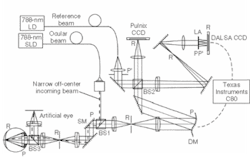Adaptive optics (AO) was first proposed in 1953 as an aid to astronomers, but the initial technology developments were focused on military applications for more than a decade. The upside of this was the achievement of impressive military results that inspired later astronomical developments. The downside was a tendency toward expensive technological solutions that were not always best suited for astronomical observations.1 Numerous innovative approaches have arisen to deal with this difficulty, however, and a similar process is now under way among researchers working to extend AO technology to human vision and to other fields that are much more cost-sensitive than applications in either the military or in observatory astronomy.
"For adaptive optics to find applications in other areas, such as long-distance horizontal laser-beam propagation or imaging, microscopy, intra- and extracavity laser correction, and even amateur astronomy, the costs of the systems must be reduced by several orders of magnitude," wrote Carl Patterson, Ian Munro, and Chris Dainty in reporting on the development of a low-cost AO system using a membrane mirror at the Imperial College of Science, Technology, and Medicine (London, England). "This goal is beginning to become more realizable with the recent developments in component technologies. In particular, there have been a number of advances in actuator technology specifically with the availability of relatively cheap electrostatic membrane mirrors, bimorph mirrors, and liquid-crystal technology."2
Luis Diaz-Santana and colleagues in the Department of Optometry and Visual Science at the City University (London, England), are collaborating with Munro, Dainty, and others to make a bridge between technology that is being developed in the laboratory and systems that are available for clinical practice. "The potential is enormous," Diaz-Santana said. "Higher-resolution retinal imaging can bring huge benefits to the general population, such as better diagnostics at earlier stages of retinal disease, better monitoring, and better information about responses to a particular treatment. At the moment, however, prohibitively high costs are inhibiting widespread use of this technology."
An alternative approach
The main cost of an AO system is the deformable mirror, which can cost from $5000 to $70,000, plus the cost of drivers, power supplies, and so on, Diaz-Santana said. The least expensive mirrors have very little stroke and cannot compensate for ocular aberrations, which sets up a need to compromise between cost and efficiency. Ameliorative hardware designs have been proposed, such as using more than one mirror or bouncing the beam twice off the same mirror. But a more clinically oriented approach involves gaining a better understanding of ocular aberrations, their dynamics, and statistical behavior to facilitate optimization of the AO control loop and optimize the performance. Such an approach might also help to design mirrors or other wavefront correctors to correct these particular aberrations, he added, ideally at a lower cost than currently available devices and systems.
This low-cost, high-speed ocular adaptive-optics system built from off-the-shelf components uses a Shack-Hartmann wavefront sensor consisting of an array of 0.2-mm-square lenslets and a high-speed CCD with 128 × 128 16-µm-square pixels (Dalsa; Waterloo, Ontario, Canada). An electrostatic membrane mirror with 37 actuators provides the correcting element (OKO Technologies; Delft, The Netherlands) and is controlled by a digital signal-processor board (Texas Instruments; Dallas, TX) housed in a standard desktop PC. The light source is a fiber-coupled superluminescent diode with a wavelength centered at 788 nm. 3
For instance, Diaz-Santana, Dainty (at the National University in Galway, Ireland), Munro, and colleagues have constructed what Diaz-Santana described as "the fastest ocular adaptive-optics system in the world" (see figure).3 The system measures aberrations at 240 Hz, with closed-loop aberration-correction rates of up to 30 Hz. "This system has shown that running at higher speeds can be beneficial when using low-cost mirrors with limited stroke," he said. The underlying purpose is to investigate an alternate method for improving the performance of an AO system. By correcting the ocular aberrations that change rapidly and have little stroke, the system relieves the mirror of the need to correct the slowly changing aberrations that have a large stroke and cannot be fully compensated, he said.
The most important aspects of the effort are to provide insight into the dynamics of ocular aberrations at very high speeds and to ask new questions about the driving forces behind those aberrations and about how those dynamics might be better exploited, he said. "This is not the only solution, but is a step forward in understanding what we can do with a system, and how we can keep costs down while maximizing performance."
REFERENCES
- F. Roddier et al., Publications of the Astronomical Society of the Pacific 103 (January 1991).
- C. Paterson et al., Optics Express 6(9) (April 24, 2000).
- L. Diaz-Santana et al., Optics Express 11(20) (Oct .6, 2003).
